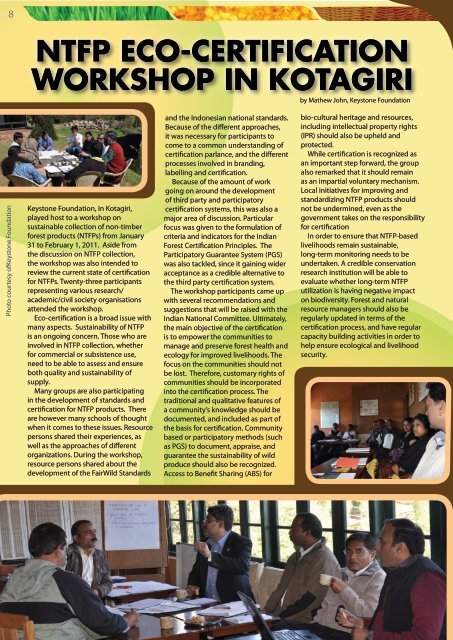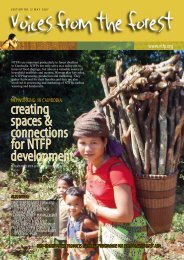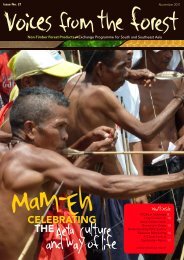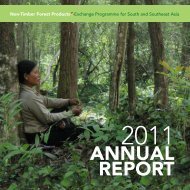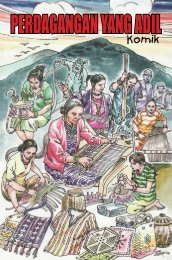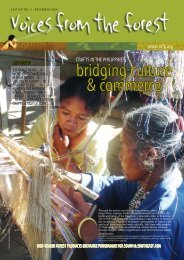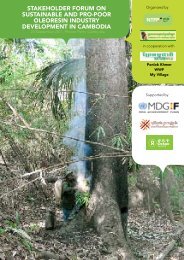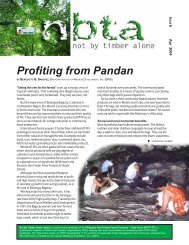Edition No. 20 - Non-Timber Forest Products Exchange Programme
Edition No. 20 - Non-Timber Forest Products Exchange Programme
Edition No. 20 - Non-Timber Forest Products Exchange Programme
Create successful ePaper yourself
Turn your PDF publications into a flip-book with our unique Google optimized e-Paper software.
8<br />
NTFP ECO-CERTIFICATION<br />
WORKSHOP IN KOTAGIRI<br />
by Mathew John, Keystone Foundation<br />
Photo courtesy ofKeystone Foundation<br />
Keystone Foundation, in Kotagiri,<br />
played host to a workshop on<br />
sustainable collection of non-timber<br />
forest products (NTFPs) from January<br />
31 to February 1, <strong>20</strong>11. Aside from<br />
the discussion on NTFP collection,<br />
the workshop was also intended to<br />
review the current state of certification<br />
for NTFPs. Twenty-three participants<br />
representing various research/<br />
academic/civil society organisations<br />
attended the workshop.<br />
Eco-certification is a broad issue with<br />
many aspects. Sustainability of NTFP<br />
is an ongoing concern. Those who are<br />
involved in NTFP collection, whether<br />
for commercial or subsistence use,<br />
need to be able to assess and ensure<br />
both quality and sustainability of<br />
supply.<br />
Many groups are also participating<br />
in the development of standards and<br />
certification for NTFP products. There<br />
are however many schools of thought<br />
when it comes to these issues. Resource<br />
persons shared their experiences, as<br />
well as the approaches of different<br />
organizations. During the workshop,<br />
resource persons shared about the<br />
development of the FairWild Standards<br />
and the Indonesian national standards.<br />
Because of the different approaches,<br />
it was necessary for participants to<br />
come to a common understanding of<br />
certification parlance, and the different<br />
processes involved in branding,<br />
labelling and certification.<br />
Because of the amount of work<br />
going on around the development<br />
of third party and participatory<br />
certification systems, this was also a<br />
major area of discussion. Particular<br />
focus was given to the formulation of<br />
criteria and indicators for the Indian<br />
<strong>Forest</strong> Certification Principles. The<br />
Participatory Guarantee System (PGS)<br />
was also tackled, since it gaining wider<br />
acceptance as a credible alternative to<br />
the third party certification system.<br />
The workshop participants came up<br />
with several recommendations and<br />
suggestions that will be raised with the<br />
Indian National Committee. Ultimately,<br />
the main objective of the certification<br />
is to empower the communities to<br />
manage and preserve forest health and<br />
ecology for improved livelihoods. The<br />
focus on the communities should not<br />
be lost. Therefore, customary rights of<br />
communities should be incorporated<br />
into the certification process. The<br />
traditional and qualitative features of<br />
a community’s knowledge should be<br />
documented, and included as part of<br />
the basis for certification. Community<br />
based or participatory methods (such<br />
as PGS) to document, appraise, and<br />
guarantee the sustainability of wild<br />
produce should also be recognized.<br />
Access to Benefit Sharing (ABS) for<br />
bio-cultural heritage and resources,<br />
including intellectual property rights<br />
(IPR) should also be upheld and<br />
protected.<br />
While certification is recognized as<br />
an important step forward, the group<br />
also remarked that it should remain<br />
as an impartial voluntary mechanism.<br />
Local initiatives for improving and<br />
standardizing NTFP products should<br />
not be undermined, even as the<br />
government takes on the responsibility<br />
for certification<br />
In order to ensure that NTFP-based<br />
livelihoods remain sustainable,<br />
long-term monitoring needs to be<br />
undertaken. A credible conservation<br />
research institution will be able to<br />
evaluate whether long-term NTFP<br />
utilization is having negative impact<br />
on biodiversity. <strong>Forest</strong> and natural<br />
resource managers should also be<br />
regularly updated in terms of the<br />
certification process, and have regular<br />
capacity building activities in order to<br />
help ensure ecological and livelihood<br />
security.


